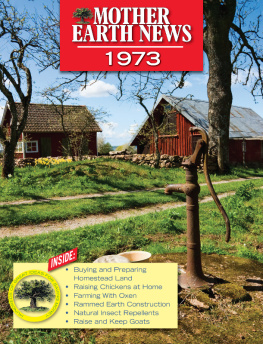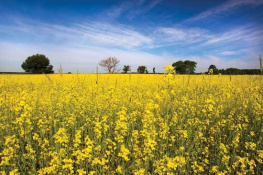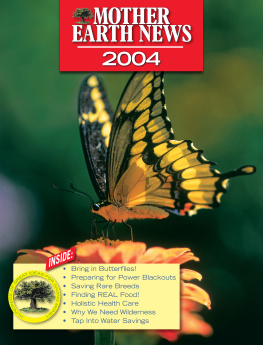Mother Earth News - Mother Earth News 2005
Here you can read online Mother Earth News - Mother Earth News 2005 full text of the book (entire story) in english for free. Download pdf and epub, get meaning, cover and reviews about this ebook. year: 2005, publisher: Mother Earth News, genre: Science / Home and family. Description of the work, (preface) as well as reviews are available. Best literature library LitArk.com created for fans of good reading and offers a wide selection of genres:
Romance novel
Science fiction
Adventure
Detective
Science
History
Home and family
Prose
Art
Politics
Computer
Non-fiction
Religion
Business
Children
Humor
Choose a favorite category and find really read worthwhile books. Enjoy immersion in the world of imagination, feel the emotions of the characters or learn something new for yourself, make an fascinating discovery.
- Book:Mother Earth News 2005
- Author:
- Publisher:Mother Earth News
- Genre:
- Year:2005
- Rating:4 / 5
- Favourites:Add to favourites
- Your mark:
- 80
- 1
- 2
- 3
- 4
- 5
Mother Earth News 2005: summary, description and annotation
We offer to read an annotation, description, summary or preface (depends on what the author of the book "Mother Earth News 2005" wrote himself). If you haven't found the necessary information about the book — write in the comments, we will try to find it.
Mother Earth News 2005 — read online for free the complete book (whole text) full work
Below is the text of the book, divided by pages. System saving the place of the last page read, allows you to conveniently read the book "Mother Earth News 2005" online for free, without having to search again every time where you left off. Put a bookmark, and you can go to the page where you finished reading at any time.
Font size:
Interval:
Bookmark:

With the price of oil above $50 a barrel, political instability in the Middle East on the rise, and little slack in the world oil economy, we need a new energy strategy. Fortunately, a new strategy is emerging using two new technologies.
Gas-electric hybrid engines and advanced-design wind turbines offer a way to wean ourselves from imported oil. If over the next decade we convert the U.S. automobile fleet to gas-electric hybrids with the efficiency of todays Toyota Prius, we could cut our gasoline use in half. No change in the number of vehicles, no change in miles driven - just doing it more efficiently. Several gas-electric hybrid car models are now on the market including the Toyota Prius, the Honda Insight and the hybrid version of the Honda Civic. The Prius - a midsize car on the cutting-edge of auto technology - gets an astounding 55 mpg in combined city/highway driving. No wonder lists of eager buyers are willing to wait six months or more for delivery.
Many other hybrid vehicles are beginning to appear in showrooms, or are scheduled to arrive soon. Ford has recently released a hybrid model of its Escape SUV, Honda has released a hybrid version of its popular Accord sedan, and General Motors will offer hybrid versions of several of its cars and trucks, including the Chevy Tahoe, the Chevy Malibu and the Saturn VUE. Beyond this, GM has delivered 235 hybrid-powered buses to Seattle. Other large cities slated to get hybrid buses are Philadelphia, Houston and Portland.
With gas-electric hybrid vehicles now on the market, the stage is set for the second step to reduce oil dependence: the use of wind-generated electricity to power automobiles. If we add to the gas-electric hybrid a plug-in capacity and a second battery to increase its electricity storage capacity, motorists could then do their commuting, shopping and other short-distance travel largely with electricity, saving gasoline for the occasional long trip. This could lop another 20 percent off gasoline use in addition to the initial 50-percent cut from shifting to gas-electric hybrids, for a total reduction of 70 percent.
The plug-in capacity gives access to the countrys vast, largely untapped wind resources. In 1991, the U.S.epartment of Energy published a National Wind Resource Inventory in which it pointed out that three states - Kansas, North Dakota and Texas - have enough harnessable wind energy to satisfy national electricity needs. Many were astonished by this news since wind power was widely considered a marginal energy source. Yet in retrospect, we know this was a gross underestimate simply because it was based on the wind turbine technologies of 1991. Advances in design since then enable turbines to operate at lower wind speeds and to convert wind into electricity more efficiently.
The average turbine in 1991 was roughly 120 feet tall, whereas new ones are 300 feet tall - the height of a 30-story building. Not only does this more than double the amount of harvestable wind, but winds at the higher elevation are stronger and more reliable.
In Europe, which has emerged as the world leader in developing wind energy, wind farms now satisfy the residential electricity needs of 40 million consumers. In 2003, the European Wind Energy Association projected that by 2020 this energy source would provide electricity for 195 million people - half the population of Western Europe. A 2004 assessment of Europes offshore potential by the Garrad Hassan consulting group concluded that if European governments move vigorously to develop this potential, wind could supply all of the regions residential electricity by 2020. Wind power is growing fast because it is cheap, abundant, inexhaustible, widely distributed, clean and climate- benign. No other energy source has all of these attributes.
The cost of wind-generated electricity has been in free fall over the last two decades. The early wind farms in California, where the modern wind industry was born in the 1980s, generated electricity at a cost of 38 cents per kilowatt-hour. Now many wind farms are producing power at 4 cents per kilowatt-hour, and some long-term supply contracts have recently been signed at 3 cents per kilowatt-hour. And the price is still falling.
Unlike the widely discussed fuel cell/ hydrogen transportation model, the gas-electric hybrid/wind model does not require a costly new infrastructure; the network of gasoline service stations is already in place. So, too, is the electricity grid needed to link wind farms to the storage batteries in cars. For this new model to work most efficiently, we would need a strong integrated national grid. Fortunately, the need for modernizing our antiquated set of regional grids, and replacing them with a strong national grid, is now widely recognized, especially after the 2003 blackout that darkened portions of the northeast United States and southeast Canada.
One of the few weaknesses of wind energy - its irregularity - is largely offset with the use of plug-in gas-electric hybrids, as the batteries in these vehicles become a part of the storage system for wind energy. Beyond this, there is always the tank of gasoline as a backup.
Some 22 states now have commercial-scale wind farms feeding electricity into the grid. Although there is occasionally a NIMBY (Not In My Back Yard) problem, the PIIMBY (Put It In My Back Yard) response is much more pervasive. This is not surprising, since a single turbine can easily produce $100,000 worth of electricity in a year. The competition among farmers in Iowa or ranchers in Colorado for wind farms is intense. Farmers, with no investment on their part, typically receive $3,000 a year in royalties from the local utility for siting a single wind turbine, which occupies a quarter-acre of land. This quarter-acre in corn country would produce 40 bushels of corn worth $120 or in ranch country perhaps $10 worth of beef.
Communities in rural America desperately want to earn the additional revenue from wind farms and the jobs they bring. In addition, money spent on electricity generated from wind farms stays in the community, creating a ripple effect throughout the local economy. Within a matter of years, thousands of farmers could be earning far more from electricity sales than from farming.
Moving to highly efficient gas-electric hybrids with plug-in capacity, combined with the construction of thousands of wind farms across the country that feed electricity into a national grid, will give us the energy security that has eluded us for three decades. It also will rejuvenate farm and ranch communities, and shrink the U.S. balance-of-trade deficit. Even more important, it will dramatically cut carbon emissions, making the United States a model that other countries can emulate.
Lester R. Brown is the founder and president of the Earth Policy Institute.
Imagine my surprise when I went into the garden this past August, and I found it littered with oddly shaped squash that resembled large chunks of hardened lava. Gray-black, other-worldly, yet hauntingly beautiful, this unique heirloom vegetable from Japan, the Yokohama squash, was a visual study in the Japanese affection for serenity through form and texture.
Not only that, the Yokohama possesses one of the most complex flavors I have run across in any squash or pumpkin I have grown. Everyones taste buds are different, but I detect hints of Asian pear, mango, avocado, lemon balsam, and if you have experience with tropical fruits, the unmistakable aroma of sapote. Can this be a squash? It is even a great boon to gardeners because it is highly resistant to borers and powdery mildew. Why didnt I know about Yokohama squash years ago?
Font size:
Interval:
Bookmark:
Similar books «Mother Earth News 2005»
Look at similar books to Mother Earth News 2005. We have selected literature similar in name and meaning in the hope of providing readers with more options to find new, interesting, not yet read works.
Discussion, reviews of the book Mother Earth News 2005 and just readers' own opinions. Leave your comments, write what you think about the work, its meaning or the main characters. Specify what exactly you liked and what you didn't like, and why you think so.



















